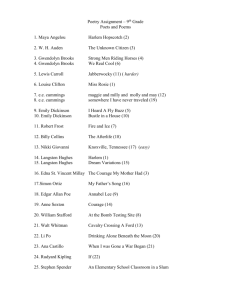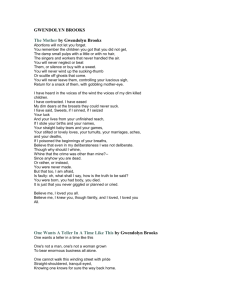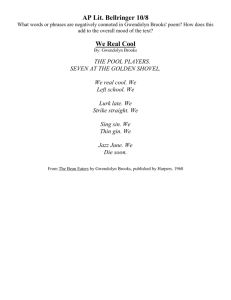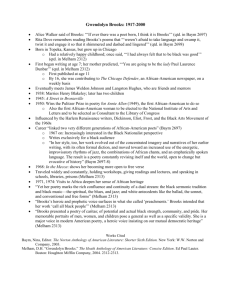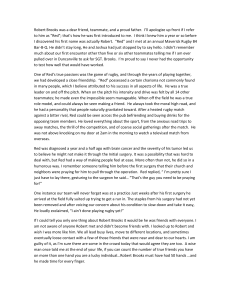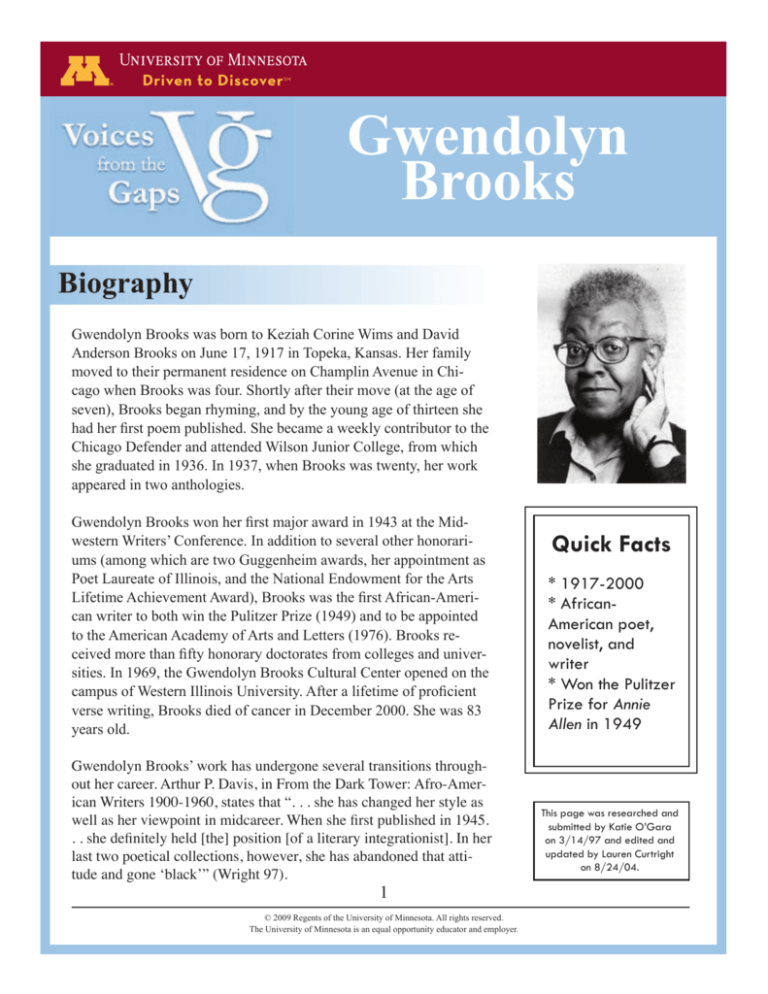
Gwendolyn
Brooks
Biography
Gwendolyn Brooks was born to Keziah Corine Wims and David
Anderson Brooks on June 17, 1917 in Topeka, Kansas. Her family
moved to their permanent residence on Champlin Avenue in Chicago when Brooks was four. Shortly after their move (at the age of
seven), Brooks began rhyming, and by the young age of thirteen she
had her first poem published. She became a weekly contributor to the
Chicago Defender and attended Wilson Junior College, from which
she graduated in 1936. In 1937, when Brooks was twenty, her work
appeared in two anthologies.
Gwendolyn Brooks won her first major award in 1943 at the Midwestern Writers’ Conference. In addition to several other honorariums (among which are two Guggenheim awards, her appointment as
Poet Laureate of Illinois, and the National Endowment for the Arts
Lifetime Achievement Award), Brooks was the first African-American writer to both win the Pulitzer Prize (1949) and to be appointed
to the American Academy of Arts and Letters (1976). Brooks received more than fifty honorary doctorates from colleges and universities. In 1969, the Gwendolyn Brooks Cultural Center opened on the
campus of Western Illinois University. After a lifetime of proficient
verse writing, Brooks died of cancer in December 2000. She was 83
years old.
Gwendolyn Brooks’ work has undergone several transitions throughout her career. Arthur P. Davis, in From the Dark Tower: Afro-American Writers 1900-1960, states that “. . . she has changed her style as
well as her viewpoint in midcareer. When she first published in 1945.
. . she definitely held [the] position [of a literary integrationist]. In her
last two poetical collections, however, she has abandoned that attitude and gone ‘black’” (Wright 97).
1
© 2009 Regents of the University of Minnesota. All rights reserved.
The University of Minnesota is an equal opportunity educator and employer.
Quick Facts
* 1917-2000
* AfricanAmerican poet,
novelist, and
writer
* Won the Pulitzer
Prize for Annie
Allen in 1949
This page was researched and
submitted by Katie O’Gara
on 3/14/97 and edited and
updated by Lauren Curtright
on 8/24/04.
Gwendolyn
Brooks
Biography continued
Despite these transitions, Gwendolyn Brooks offers insight into
African-American culture, commentary on the impact of racial and
ethnic identity on life, and a vision of the pressures of day-to-day
existence throughout all of her literature. All three of these themes
take precedence in Maud Martha, Brooks’ novel. From early in her
life, Maud Martha Brown is repeatedly subjected to racial prejudice from within, and outside of, her community. She comes to
regard herself as less attractive than other African-American girls
because of her darker skin color, and she is repeatedly treated as
undesirable by members of other ethnic groups; for example, when
she is unable to pay the full price for the merchandise at a hat
store, the white sales clerk treats Maud Martha in a belittling manner. The apartment in which Maud Martha and her husband, Paul
Phillips, live provides a view into African-American life and daily
existence. After moving into their new home, Maud Martha notices
that “there was a whole lot of grayness here” (Brooks 64). Day to
day life for Maud Martha is an ordeal and offers little excitement
and few meaningful rewards. Despite this, a true sense of community among the residents does exist -- Maud Martha’s neighbors
come rushing to her aid when she gives birth to her daughter.
This view into African-American culture recurs in several of Brooks’ other works, including The
Bean Eaters (a view into the life of impoverished yet content elderly African-Americans) and We
Real Cool (a stream of thoughts of poor inner-city African-Americans who have adopted a hoodlum
lifestyle). The most dominant theme in Brooks’ work is the impact of ethnicity and life experiences
on one’s view of life. Brooks incorporates this belief into “Young Heroes: To Keorapetse Kgositsile
(Willie)” in her collection Family Pictures. While most readers may regard Afrika (the focal character
of “Young Heroes”) as a “horror . . . in working clothes” (Brooks 15), Brooks looks up to him as the
man who will enlighten the African-American race through his teachings.
2
© 2009 Regents of the University of Minnesota. All rights reserved.
The University of Minnesota is an equal opportunity educator and employer.
Gwendolyn
Brooks
Biography continued
Many critics say Brooks has been underappreciated. According to James M. Johnson of Ramparts, “No
white poet of her quality is so undervalued, so unpardonably unread. She ought to be widely appreciated. .
. as one of our most remarkable woman poets. . . . “ (Wright 46). While her poetry has been well-received
by many critics, Maud Martha has not gained as much praise. Noel Schraufnagel regards Maud Martha as
“. . .the type of enduring black woman that has become a stereotype” (Wright 136), essentially revealing his
opinion that Brooks has done nothing new in this work. Despite Schraufnagel’s rather negative view of the
novel, several other critics have looked upon it favorably; for example, Barbara Christian praises the book’s
“[heightening of] our awareness of the wonderfulness of the commonplace” (Wright 136).
Selected Bibliography
Works by the author
Report from Part Two (Third World Press, 1996)
Children Coming Home (The David Company, 1988)
Gottschalk and the Grande Tarantelle (Third World Press, 1988)
Winnie (Third World Press, 1988)
Blacks (Third World Press, 1987)
Mayor Harold Washington and Chicago, the I Will City (Brooks Press, 1983)
Very Young Poets (Brooks Press, 1983)
To Disembark (Third World Press, 1981)
Primer for Blacks (Brooks Press, 1980)
Beckonings (Broadside Press, 1975)
The Tiger Who Wore White Gloves, or What You Really Are, You Really Are (Third World Press,
1974)
Aloneness (Broadside Press, 1971)
Black Steel: Joe Frazier and Muhammad Ali (Broadside Press, 1971)
A Broadside Treasury (Broadside Press, 1971)
Jump Bad (Broadside Press, 1971)
The World of Gwendolyn Brooks (Harper & Row, 1971)
3
© 2009 Regents of the University of Minnesota. All rights reserved.
The University of Minnesota is an equal opportunity educator and employer.
Gwendolyn
Brooks
Selected Bibliography continued
Works by the author continued
Family Pictures (Broadside Press, 1970)
Riot (Broadside Press, 1969)
In the Mecca (Harper & Row, 1968)
The Wall (Broadside Press, 1967)
We Real Cool (Broadside Press, 1966)
Selected Poems (Harper & Row, 1963)
The Bean Eaters (Harper, 1960)
Bronzeville Boys and Girls (Harper, 1956)
Maud Martha (Harper, 1953)
Annie Allen (Harper, 1949)
A Street In Bronzeville (Harper, 1945)
Works about the author
Brown, Patricia L. , Don L. Lee, and Francis Ward, eds. “To Gwen, with Love” (Colorado
Review, 1989).
Callahan, John. F. “Essentially an Essential African: Gwendolyn Brooks and the Awakening to
Audience” (North Dakota Quarterly, 1987).
Childress, Paulette. A Womanist Social Protest Tradition in Twentieth Century African-American
Literature: Fiction by Marita Bonner, Ann Petry, Dorothy West, and Gwendolyn Brooks
(Dissertation Abstracts International, Section A: The Humanities and Social Sciences,1999).
Davis, Arthur P. From the Dark Tower: Afro-American Writers 1900-1960 (Howard University
Press, 1974).
Dworkin, Ira. “‘The Evading Eye’: The Transgeneric Prose of Gwendolyn Brooks” (CLA
Journal, 2003).
Gery, John. “Subversive Parody in the Early Poems of Gwendolyn Brooks” (South Central
Review: The Journal of the South Central Modern Language Association, 1999).
Hubbard, Stacy Carson. “‘A Splintery Box’: Race and Gender in the Sonnets of Gwendolyn
Brooks” (Genre: Forms of Discourse and Culture, 1992).
4
© 2009 Regents of the University of Minnesota. All rights reserved.
The University of Minnesota is an equal opportunity educator and employer.
Gwendolyn
Brooks
Selected Bibliography continued
Works about the author continued
Iker, Karen. “‘The Bit of Art, That Could Not Come from Any Other’: Gwendolyn Brooks’s
Maud Martha and the Bildungsroman Revised” (In Process: A Graduate Student Journal of
African-American and African Diasporan Literature and Culture, 1996).
Johnson, Mark. “Brooks’ ‘Gang Girls’” (Explicator, 2003).
Kent, George E. A Life of Gwendolyn Brooks (University Press of Kentucky, 1990).
Kufrin, Joan. “Gwendolyn Brooks” in Uncommon Women (New Century Publishers, 1981).
Loff, Jon N. “Gwendolyn Brooks: A Bibliography” (College Language Association Journal,
1973).
Lowney, John. “‘A Material Collapse That Is Construction’: History and Counter-Memory in
Gwendolyn Brooks’s In the Mecca” (MELUS: The Journal of the Society for the Study of the
Multi-Ethnic Literature of the United States, 1998).
Madhubuti, Haki R. , ed. Say That the River Turns: The Impact of Gwendolyn Brooks (Third
World Press, 1987).
Melhem, D. H. Gwendolyn Brooks: Poetry and the Heroic Voice (University Press of Kentucky,
1987).
---. “Gwendolyn Brooks: Humanism and Heroism” in Heroism in the New Black Poetry:
Interviews and Interviews (University Press of Kentucky, 1990).
Mihaila, Rodica. “Metamorphoses of Blackness in the Poetry of Gwendolyn Brooks” (B. A. S. :
British and American Studies/Revista de Studii Britanice si Americane, 1998).
Miller, R. Baxter. Langston Hughes and Gwendolyn Brooks: A Reference Guide (G. K. Hall,
1978).
Mootry, Maria K. , and Gary Smith. A Life Distilled: Gwendolyn Brooks, Her Poetry and Fiction
(University Press of Illinois, 1987).
Shaw, Harry B. Gwendolyn Brooks (Twayne, 1980).
Wright, Stephen Caldwell. The Chicago Collective: Poems for and Inspired by Gwendolyn
Brooks (Christopher-Burghardt, 1990).
---, ed. On Gwendolyn Brooks: Reliant Contemplation (University of Michigan Press, 1996).
Various authors. “Gwendolyn Brooks: A Symposium” (Field: Contemporary Poetry and Poetics,
Fall).
5
© 2009 Regents of the University of Minnesota. All rights reserved.
The University of Minnesota is an equal opportunity educator and employer.
Gwendolyn
Brooks
Archives
Correspondence
James A. Emanuel Collection, General Correspondence, 1948-1994, n.d. , Box 1, Gwendolyn
Brooks, 1970-1974, Manuscript Division, Library of Congress, Washington, D.C.
James Bertolino, Papers, 1968-1980, letters to JB from Gwendolyn Brooks, Ohio University
Libraries
Joyce Ann Joyce, Papers, 1950?-2001, [Folder 14] Joyce Papers: Correspondence - Gwendolyn
Brooks, Valdosta State University.
Hoyt Fuller, Papers, 1940-1981, Personal Correspondence (1953-1981), Atlanta University
Center, Georgia.
Records, 1959-1984, Correspondence of Robert Burns, executive editor of US Catholic, 1959 1984; Correspondents include Brooks; University of Notre Dame Libraries.
Papers of [Francis] Coleman Rosenberger, 1946-1952, Series II: Letters and Postcards, from
Brooks, Nov. 30, 1946, University of Virginia Libraries.
Hannah Kahn, Papers, 1940-1987, Series 2, 1957-1986; includes correspondence with Brooks;
University of Florida Libraries. Letter to Gwendolyn Brooks, Oct. 4, 1956, from Langston
Hughes, University of Virginia Libraries.
Jack Conroy Papers, 1924-1991, Newberry Library, Chicago, IL.
Poetry
The Frank P. Piskor Collection of Robert Frost; includes poetry written by Gwendolyn Brooks
on the occasion of Frost’s death; St. Lawrence University Libraries.
6
© 2009 Regents of the University of Minnesota. All rights reserved.
The University of Minnesota is an equal opportunity educator and employer.

